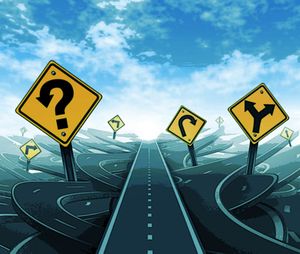I submitted grades for my summer WritDM course this morning. I had an attrition rate of about one-third, which is normal, another third delivering perfunctory and often-tardy work, and another third embracing the material and doing well. I have found that in most cases, those who do the work on-time do much better in the course. Those who procrastinate tend to fail, or scramble to catch up, struggle, and end up hating the class.

Wikipedia is not one of those platforms that you can just pick up at the last minute. If you have not been doing the training throughout the term and actually practicing regularly, you will probably have a miserable time and deliver poor results. This is a constant struggle for many of the students: I guess our current model of education encourages procrastination on semester projects, like research papers. Yet, the difference between writing a research paper and a Wikipedia article is that with the former, students do not have to learn the medium. This fact is key, I think, for the poor performance of many students: they assume the medium will be transparent, so they can wait longer to get started.[1]
This is why I do not use D2L.
Or one of the reasons. D2L is poorly designed software that has been pushed upon the university community for political reasons, kind of like Microsoft Office.[2] Elsewhere, I write:
| “ | We might stop for a moment to consider the damage that Microsoft has done to software design — so much, in fact, that we’re still trying to recover. Now, I don’t want to pull out the soapbox, but folks, please stop using shitty, bloated software! I’m sure there are some professionals out there that might need some of the cumbersome features of Word, but I know not one of them. I don’t need it. My students certainly don’t need it. Why, then, do all of my students insist on putting it on their new computers? Why does my college insist on putting it on every computer on campus? Why do we still reward Microsoft for crippling the software industry? M$ Office is needlessly terrible software that we should stop using. | ” |
The thing about poor software like D2L and Word is that we force them upon our communities as the only options, so we go through the hardship of learning them. Since everyone has to learn it, they become invested, so even if there are other options or another, newer one is presented, we default to the worse one because it’s the one we know.
When we compel the use of any medium, we’re teaching students not to think critically about their use of it.

For example, here's part of a student’s reflection on the semester, something I often have my students do as their last assignment:
| “ | Initially, I was a bit intimidated by this class. This anxiety mostly came from the lack of familiar structure. D2L is within my comfort zone and having to navigate between different sites was not in that comfort zone. It is easier to keep track of things when they are logged onto one site, and a bit more difficult when I am not able to see my grades at all. The class itself was not something I enjoyed very much, but this is largely due to the structure and not the context. | ” |
This paragraph proves my point perfectly. Like the classroom itself as a medium,[3] D2L teaches students to be students: to be dependent on a particular structure so that when it’s removed, they become anxious and uncomfortable, almost unable to function. This atrophies a student’s ability to adapt and think outside the box—to question an imposed structure rather than become dependent upon it. Different is interpreted as worse because we have forced students to use a system, made them dependent on it, and removed students’ ability to consider it critically. Because of its compelled ubiquity, D2L has become synonymous comfortable, organized structure.[4]
D2L has become transparent, and that fact is not healthy in an academic community. Bolter and Grusin define media transparency as an immediacy that erases the medium so the users are no longer aware of it.[5] Transparency removes the presence of the medium, and therefore, the users’ ability to critique it. We should use platforms that require students to pause, step back, and proceed carefully and deliberately.[6] This is one of the reasons I teach WritDM using Wikipedia. The writing here, in part, emphasizes the role of the medium in composition, and this is a necessary component in the class: it’s the “digital media” part.
I have an obligation to choose the best platform available at the time for my desired outcomes. This is an ethical matter that we educators should take seriously. If Marshall McLuhan is correct when he writes “the ‘content’ of any medium blinds us to the character of the medium”[7] and “any medium has the power of imposing its own assumption on the unwary,”[8] then don’t we have an obligation not to embrace the status quo and encourage students to be more critical of the technologies that shape their lives? I think we do. Rather than teaching a dependance on certain arbitrary platforms (especially from ethically dubious corporations), let’s teach them the skills to be more creative, adaptable, and critical.
notes
- ↑ Even though I warn them multiple times and in multiple places on the syllabus, they either do not believe me, or more likely, do not read the syllabus to begin with.
- ↑ I don’t know this for sure, but I was part of the campus community asked to help choose a new LMS for the university system, probably over a decade ago now. We had a number to test and evaluate, and I took the job seriously. D2L was at the bottom of my list for several reasons, it’s proprietary, clunky, and way too complex for most of us who will be using it. God, the gradebook alone was (and still is) not only a nightmare to set up, but also to make sense out of. In fact, most of the committee ranked D2L at the bottom. Well, guess which was chosen. Like I said, I assume this is politics, because it certainly wasn’t about pedagogy.
- ↑ Think about the design of the classroom: it privileges the instructor, giving her the whole front of the classroom, while compelling students to take a seat in a grid, facing the important part of the room, remain silent, and pay attention. The militaristic structure of the classroom imposes certain behaviors, implies a hierarchy of command and control, and thereby molds them into students, not creative thinkers. This is how education was designed, but it’s obsolete, unless it’s our goal to teach them to be dutiful workers for a corporation. Hm. Is it? Are we a university or a branch of EduCorp?
- ↑ There is now an even more concerted, official effort to make all classes look the same in D2L. I get why administrators think this is a good idea—we can’t have the platform getting in the way of the content—but this type of corporate approach to education will ultimately do them more harm than good. When they leave the university, they can’t take D2L with them. What then?
- ↑ Bolter, Jay David; Grusin, Richard (1999). Remediation: Understanding New Media. Cambridge, MA: MIT Press. p. 24.
- ↑ I think this shows a key difference in software design: while we want software to be “intuitive”—logical design—we don’t want it to be transparent—something that has trained us to behave in a certain way. Yes, the intuitive often leads to the transparent, but it doesn’t have to. Think of driving a manual car. This interface is not intuitive, but we master it, or become fluent through many starts and stops. After a while it becomes transparent, in that we no longer have to think about the mechanics of driving. IN essence, the poor interface has trained us how to use it.
- ↑ McLuhan, Marshall (2004). "The Medium Is the Message". In Wardrip-Fruin, Noah; Harrigan, Pat. First Person: New Media as Story, Performance, and Game. Cambridge: MIT Press. p. 203. ISBN 0262232324.
- ↑ McLuhan 2004, p. 206.
